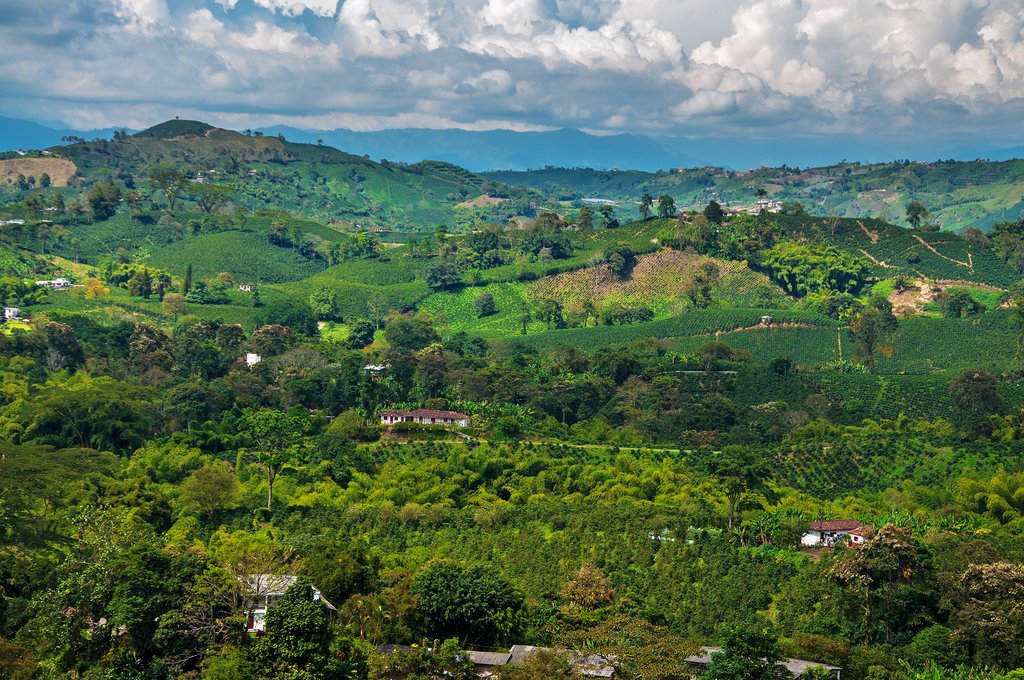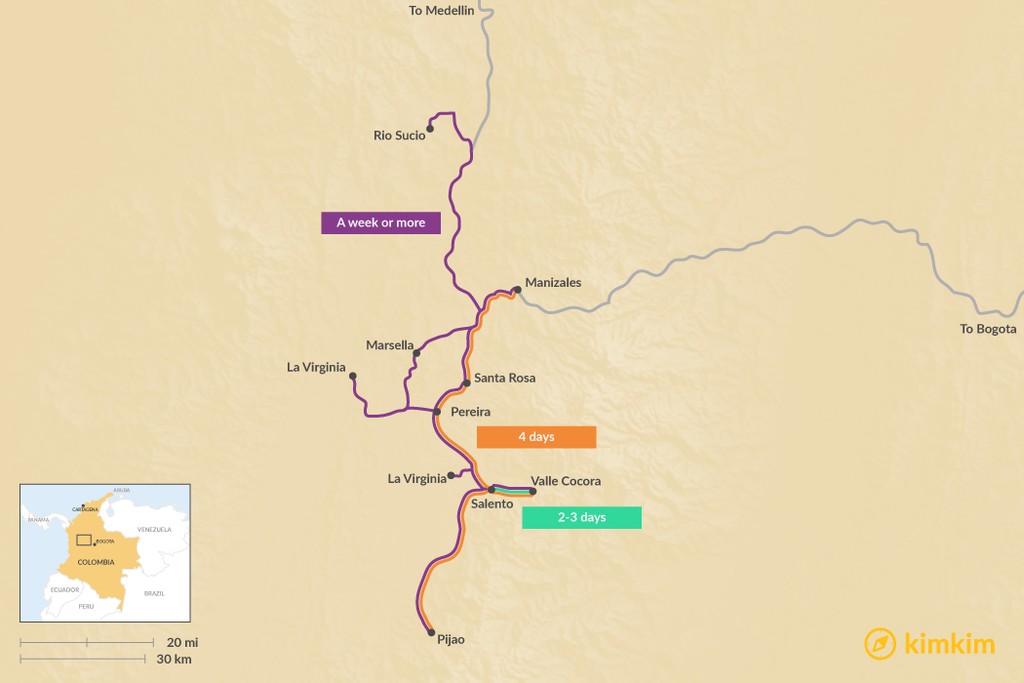Tips & Local Insights
- Spend a night on a traditional coffee farm and learn the art of coffee production
- For the best nature views, take a short hike in the stunning Valle Cocora
- Check out the hot springs of Termales San Vicente near Manizales
- Unwind and relax in Pijao, South America's first designated "slow town"
- Enjoy Salento, a charming city with great mountain views and excellent food
- Dress in layers and carry an umbrella; weather can vary dramatically between coffee region cities and microclimates
Overview
Colombia's Coffee region (also called the Coffee Axis or in Spanish, Eje Cafetero) spans three departments: Caldas, Risaralda, and Quindío. Visiting the area is similar to a tour of the Wine Country in northern California: you can visit coffee plantations as you would wineries, touring the fields and sampling the finished product.
Many of the farms supplement their income with tourism and will offer a detailed showing of how the coffee is picked, produced, and readied for export. This guide will direct you to the best places to see the coffee production process, the best times to visit the area, as well as places to stay and when to visit.
Places to Visit & Things to Do
The Coffee Region has three medium-sized cities plus a smattering of smaller towns and villages nestled amid the green valleys and connected by narrow country roads. The best places to visit in the region are often tiny pueblos surrounded by coffee farms, but there are also bigger cities where you can experience excellent museums and cultural events. In addition to plantation tours, the region has a number of other unique attractions and activities. You can visit stunning nature reserves and waterfalls, or go mountain biking and canyoneering.
Chat with a local specialist who can help organize your trip.
Best Time to Visit

Colombia's peak travel seasons are July to August and December to March, as these months align with the dry weather and the holidays for both international as well as domestic travelers. Expect larger crowds during peak times, especially between December and January. Prices for hotels and flights during these months also increase. Other times of the year, the wet months of April through June and September through November, see fewer visitors and lower accommodation prices, making these off-season months a good time to visit.
The most interesting period to visit is during coffee harvest season, from April to May or October to December. Though rainy, the farms will be at their most active during this period, making for some excellent photo opportunities.
Festivals & Special Events
Feria de Manizales, Manizales (January). A major celebration lasting most of the month, it features a locally inspired program that includes bullfights, cultural music and dance performances, horse parades, and artisan exhibitions.
Fiesta Nacional de Cafe (June). The annual Coffee Festival features Colombia's most famous Jeep parades (Yipao). Visitors will experience the marvel of coffee Jeeps loaded to capacity and proving themselves with feats of prowess and strength to showcase the stability and culture surrounding Jeep Willy. This is a must-see for travelers who are traveling this month.
Fiestas de las Cosechas (August). This event includes an annual parade, an International Gastronomic Festival, concerts, local musicians, art exhibits, and street markets featuring local products.
Festivo de Sabores, Sonidos y Saberes, Pijao (September). Pijao is dedicated to fresh coffee, local food, and regional culture in an area that is developing its unique infrastructure.
Concurso Nacional de Velas y Faroles, Quimbaya (December). A Christmas celebration lit by beautiful paper lanterns, the National Candles and Lanterns Competition is located in the pueblo of Quimbaya. The streets will be filled with lanterns carefully prepared by the local populace months ahead of time. Be sure to plan a night stay if you attend, as crowds are large and chaotic for this famous yet beautiful event.
How Many Days To Spend

To see all the highlights of Colombia's coffee region, you'll need around 7-8 days. If time is a factor, you can still plan a great experience in 2-3 days where you can spend a night on a coffee farm and visit Salento and Valle Cocora. With four days, you could then add on Pijao, Santa Rosa, Manizales, and Pereira. With a week or more, you could include Rio Sucio, Marsella, La Virginia, and Filandia in your itinerary.
Transport Options

By public bus or van
Private vans to Pereira (in the heart of the region) take 4-5 hours from Medellín. Public buses also depart frequently during the day. VivaColombia offers flights between these two cities. The trip to Pereira from Bogotá by bus is a long haul, taking 8-9 hours, especially when crossing La Linea, a mountain pass that tops 10,000 feet (3,048 m) above sea level. Bus drivers run the air-conditioning all the time, so bring a blanket!
By private car
By car, you could arrive within 6-8 hours, depending on visibility, road conditions, and traffic. Tour operators can arrange for a car, driver, and guide to meet you at your hotel, from where you can set off for the main sites. With your own car, you can cross the entire region in one long day (but it's better to take your time).
With the exception of Rio Sucio, most destinations within the region can be reached within 1-2 hours from Pereira. Road conditions are generally good, although many of the mountain roads can make for difficult driving. A guide and driver are a good idea in this area as public transportation to the coffee farms and nature reserves is infrequent or non-existent.
By plane
Flights from Bogotá and Medellín are available to the main cities in the area—Pereira, Manizales, and Armenia. Flights out of Manizales tend to be less reliable due to frequent cancellations caused by low clouds and poor visibility. Pereira often experiences turbulence, and visibility seems to be lower more frequently, due to climate change affecting normal weather patterns. However, the Pereira airport has plans for upgrades and expansion. Be sure to arrive at least an hour early for national departures and two hours early for international flights.
Where to Stay

Hotels
Colombia's Coffee region has a range of great boutique hotel options. You can stay in the big cities (Manizales, Pereira, and Armenia), but to get a better feel for the area and its history and culture, we recommend staying overnight in the smaller towns, such as Solento and Filandia. In these pueblos, you'll find homey accommodation in renovated farmhouses and colonial-era homes.
Traditional Haciendas (Coffee Farms)
These days, many coffee plantations (as well as farms growing other produce) offer accommodation, with old haciendas and guest quarters transformed into hotels that cater to guests. Besides offering unique and comfortable lodging, they also offer activities such as horseback riding, Jeep tours, and bird watching.
One of the best-known is Hacienda Venecia, one of the oldest and most well-established coffee farms in the region. Today, you can stay in the original, fully restored plantation house, where you will get a feel for the traditional architecture and culture of this region.
What to Eat
The single most famous local dish in the Coffee Region is Bandeja Paisa, or the Paisa Flag. This colorful dish was designed for the farm worker. It is high in protein, carbs, and fat to support the needs of the hard work and rugged terrain. Today, it's a delicacy reserved for special occasions. The plate consists of chorizo, ground beef, beans, rice, avocado, a fried egg, fried plantain, and arepa. If you're a light eater, this is usually a good plate to split between two people.


